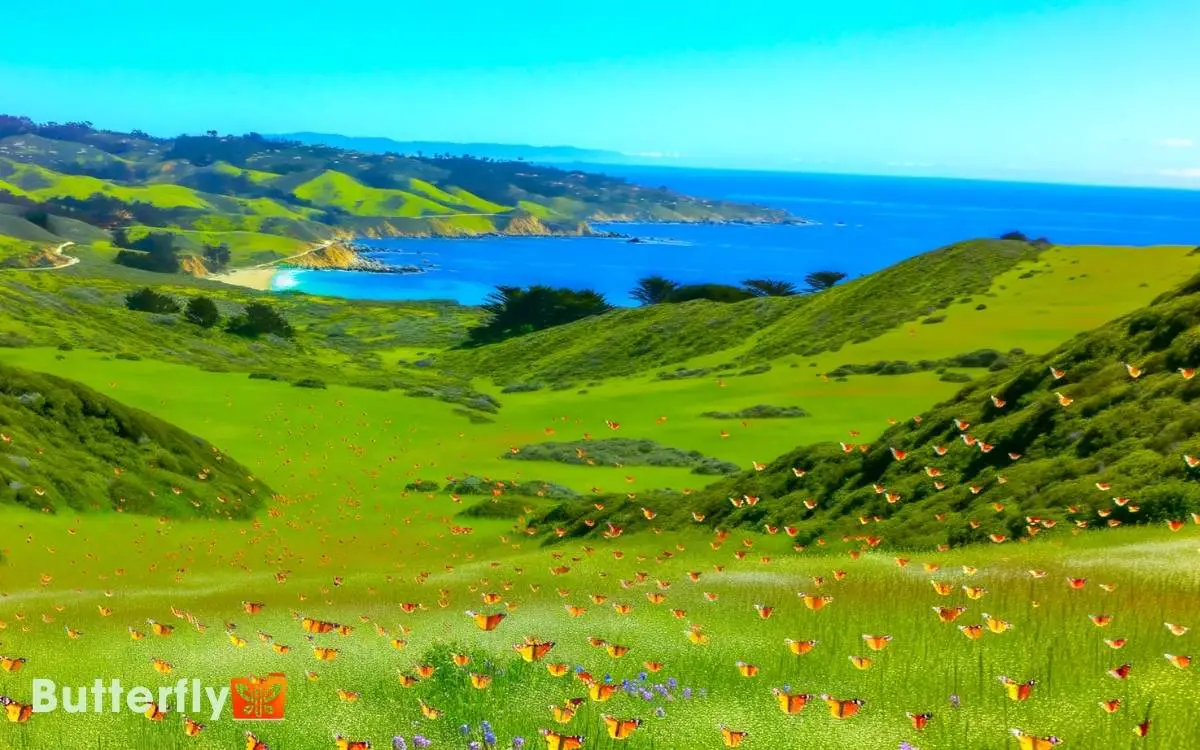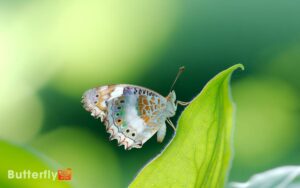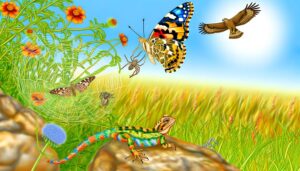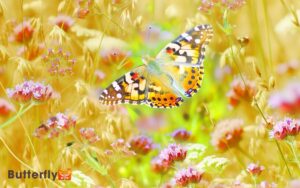Painted Lady Butterfly California Migration Path: A Guide!
The Painted Lady butterfly migrates through California starting in early spring. Overwintering populations leave desert regions in Mexico, progressing north to exploit blooming plants.
Their journey includes crossing arid landscapes, moving through areas like Anza-Borrego Desert State Park, and stopping at key sites such as Carrizo Plain and Monterey Bay for nectar.
The butterflies’ migration impacts ecosystems by aiding in pollination. Climate change, urbanization, and agriculture influence their routes and timings. Scientific studies track their movements and support conservation efforts essential for their survival.
Understanding these patterns can reveal deeper insights into ecological dynamics and conservation needs.

Key Takeaways
Overview of Migration
The painted lady butterfly’s migration in California is a vital, guarantee, and ideal multi-generational journey driven by seasonal changes and resource availability.
Their migration begins in early spring, with adults moving north from desert regions where they overwinter. As they progress, each generation advances further, exploiting newly available food sources. The migration continues until summer, when they reach northern areas.
Here, they reproduce and the cycle repeats, with new generations eventually heading south as fall approaches. This movement guarantees that the butterflies can exploit ideal habitats and resources year-round.
Understanding this migration pattern is essential for conservation efforts, as it highlights the butterflies’ dependency on specific ecological conditions to complete their life cycle successfully.
Historical Context
The Painted Lady butterfly’s migration has deep roots in Indigenous cultural practices and beliefs. Early migration records, dating back centuries, indicate consistent patterns across California.
Changes in environmental conditions have since altered these historical migration routes, impacting both the butterflies and surrounding ecosystems.
Indigenous Cultural Significance
Indigenous communities across California have long revered the Painted Lady butterfly, integrating its migration patterns into their cultural narratives and seasonal practices. These butterflies are often seen as symbols of transformation and renewal.
Tribes such as the Chumash and Miwok have created stories and ceremonies around the butterfly’s migrations, marking important seasonal changes.
The migration serves as an ecological indicator, signaling shifts in weather and the availability of resources. Traditional ecological knowledge, passed down through generations, includes observations of the butterflies’ behaviors, which inform agricultural and hunting practices.
Additionally, artistic representations of the Painted Lady appear in indigenous crafts, illustrating its significance. This deep-rooted cultural connection highlights the butterfly’s essential role in the heritage of California’s indigenous peoples.
Early Migration Records
Early settlers in California documented the Painted Lady butterfly migrations as early as the mid-1800s, noting their regularity and vast numbers. These early records provided valuable insights into the migration patterns of this species.
Observers frequently described the following:
- Massive Swarms: Settlers reported swarms so dense they darkened the sky.
- Seasonal Timing: Migrations typically occurred in spring, aligning with specific climatic conditions.
- Geographical Range: Butterflies traveled from the deserts of Mexico through California’s inland valleys.
- Behavioral Patterns: The butterflies exhibited consistent flight paths, often following natural landmarks.
These detailed observations laid the groundwork for modern scientific studies, enhancing our understanding of Painted Lady migrations. They highlight how historical data can inform contemporary research efforts.
Environmental Impact Changes
While early settlers’ records highlighted the regularity of Painted Lady migrations, subsequent environmental changes have greatly impacted these patterns.
Human activities such as urbanization, agriculture, and climate change have altered the butterflies’ habitats and food sources.
Urban development reduces the availability of native plants, while pesticide use in agriculture decreases insect populations critical for their survival.
Climate change disrupts migration timings and routes by altering temperature and precipitation patterns.
| Environmental Factor | Impact on Migration |
|---|---|
| Urbanization | Habitat loss, reduced food sources |
| Agriculture | Pesticide use, loss of nectar plants |
| Climate Change | Altered temperatures, disrupted timing |
These changes necessitate ongoing research to understand and mitigate the impacts on Painted Lady populations, ensuring their continued migration and ecological roles.
Starting Point: Mexico
The Painted Lady butterfly’s migration starts in northern Mexico, where the larvae hatch and develop before starting on their journey northward. This region provides the ideal conditions for their early life stages due to its warm climate and abundant food sources.
The butterflies follow a precise sequence of developmental stages:
- Egg: Females lay eggs on host plants like thistles and mallows.
- Larva: The hatched larvae, or caterpillars, feed voraciously on these plants.
- Pupa: Caterpillars then transform into pupae, safely encased in chrysalises.
- Adult: Fully-formed butterflies emerge, ready to begin their migration.
These stages make sure the Painted Lady is well-prepared for the arduous trek northward, setting the stage for their remarkable migration.
Crossing the Desert
As Painted Lady butterflies traverse the desert, they face significant challenges due to the arid climate.
The scarcity of water and vegetation makes finding essential rest stops vital for their survival. These rest stops provide the necessary resources for hydration and nourishment, enabling them to continue their migration path.
Challenges of Arid Climate
Painted Lady butterflies encounter significant survival challenges when crossing California’s arid desert regions. The harsh climate imposes several obstacles that test their resilience and adaptability.
Key challenges include:
- Extreme Temperatures: Daytime heat can exceed 100°F, causing dehydration and heat stress.
- Scarcity of Nectar: Limited flowering plants reduce available food sources, impacting energy levels.
- Predators: Birds and other insects exploit the butterflies’ weakened state, increasing mortality.
- Strong Winds: High winds can disorient and exhaust the butterflies, diverting them off course.
These factors create a formidable environment that requires the Painted Lady butterflies to utilize their innate survival strategies. Understanding these challenges highlights the remarkable endurance of these insects during their migratory journey across the desert.
Essential Rest Stops
Strategically located along their migratory path, key rest stops provide essential resources for Painted Lady butterflies to replenish energy and survive the desert crossing.
These rest stops are typically areas with abundant nectar sources, such as wildflowers and flowering shrubs. They supply the necessary carbohydrates for the butterflies’ long flights.
Additionally, these locations often have water sources that help maintain hydration levels important for their metabolic processes. The butterflies also find temporary shelter from harsh desert winds and extreme temperatures.
Conserving energy during these rest periods is important for the Painted Lady’s successful migration.
By utilizing these strategic points, the butterflies can effectively manage the arduous journey across the desert, ensuring higher survival rates and successful continuation of their migratory cycle.
Entering California
The Painted Lady butterflies enter California primarily through the southern deserts, following their migration route from Mexico.
Making their way through the arid landscape, they utilize various features that facilitate their journey:
- Desert wildflowers: Blooming in early spring, these flowers provide essential nectar sources.
- Riparian zones: Waterways and lush vegetation in these areas offer hydration and rest.
- Mountain passes: Natural corridors that help butterflies bypass more hostile desert regions.
- Wind currents: Favorable winds assist in conserving their energy over long distances.
These elements are essential for the Painted Lady’s successful entry into California. Understanding these factors helps researchers predict migration patterns and supports conservation efforts aimed at maintaining these critical resources.
Coastal Routes
Along California’s coastline, Painted Lady butterflies favor specific habitats that support their seasonal migrations. These patterns are influenced by factors such as temperature, wind currents, and availability of food sources.
Understanding these environmental impact factors is essential for predicting and supporting their migratory routes.
Preferred Coastal Habitats
California’s coastal habitats offer the Painted Lady butterfly essential resources for their migratory journey. These habitats provide important conditions that support their lifecycle and migration needs.
Key elements of these coastal habitats include:
- Nectar-rich flowers: Coastal regions boast a diverse array of wildflowers such as thistles and daisies, providing essential nectar.
- Sheltered resting areas: Cliffs and dunes offer protection from harsh winds and predators.
- Moisture sources: Proximity to the ocean ensures consistent humidity, important for butterfly hydration.
- Diverse plant life: Host plants like mallow and nettle are abundant, serving as breeding grounds.
These elements collectively facilitate the Painted Lady’s successful migration along California’s coast, ensuring they can feed, rest, and reproduce effectively.
Seasonal Migration Patterns
Utilizing the resources of coastal habitats, Painted Lady butterflies set out on their seasonal migration along well-defined routes that maximize their survival and reproductive success.
Researchers have identified that these butterflies follow a north-south trajectory along the California coast.
The journey begins in the early spring when they leave their overwintering grounds in Mexico and Southern California. They travel northward, taking advantage of the blooming flora and favorable coastal winds.
The coastal routes provide essential nectar sources and suitable breeding sites, allowing them to lay eggs at various intervals. By late summer, the new generation returns south, completing the cycle.
This migration pattern ensures that Painted Lady butterflies continually exploit ideal conditions, maintaining their populations year after year.
Environmental Impact Factors
Environmental factors greatly impact the Painted Lady butterfly’s coastal migration routes, affecting their access to resources and overall survival.
These factors include:
- Temperature Variations: Sudden changes in temperature can disrupt the butterflies’ physiological processes, affecting their flight patterns and energy levels.
- Wind Patterns: Strong coastal winds can either assist or hinder their journey, influencing the direction and speed of their migration.
- Availability of Nectar Sources: The presence of flowering plants along the coast is critical for providing the necessary energy for migration.
- Habitat Loss: Coastal development and urbanization reduce the availability of resting and feeding sites, critically impacting the butterflies’ ability to survive the long journey.
These elements collectively shape the migration success of the Painted Lady butterfly.
Inland Routes
The Painted Lady butterfly‘s inland migration routes often traverse through arid landscapes, taking advantage of seasonal blooms and favorable wind currents.
These butterflies utilize the abundant nectar sources from flowering desert plants, such as the brittlebush and desert marigold.
Their migration patterns are strongly influenced by the availability of these floral resources, which provide essential energy reserves. In addition, favorable wind currents help to facilitate long-distance travel by reducing the energy expenditure required for flight.
The interplay between these wind currents and the butterflies’ navigational abilities guarantees efficient migration.
Consequently, their inland routes aren’t random but strategically planned to optimize both resource acquisition and energy conservation, ensuring successful migration to their breeding grounds.
Key Stopover Sites
Several key stopover sites along the Painted Lady butterfly’s migration path in California serve as essential rest and refueling points, supporting their long-distance journey.
These sites provide important resources like nectar and shelter, which are essential for their survival and continued migration.
Key stopover sites include:
- Anza-Borrego Desert State Park: Rich in wildflowers, it offers abundant nectar sources early in the migration.
- Carrizo Plain National Monument: Known for its vast fields of blooming flora, it’s an important mid-migration refueling point.
- Monterey Bay: Coastal gardens and parks provide a diverse variety of flowering plants.
- Point Reyes National Seashore: Diverse habitats, including coastal scrub and grasslands, support various stages of the butterflies’ lifecycle.
These sites significantly impact migration success.
Challenges Faced
Painted Lady butterflies encounter numerous obstacles during their migration. These challenges include habitat loss, climate change, and pesticide exposure.
Urban development reduces the availability of essential host plants, affecting their breeding and feeding grounds. Climate change alters weather patterns, leading to unpredictable temperatures and shifts in seasonal timing that disrupt their migratory routes.
Pesticide exposure, particularly from agricultural practices, poses a significant threat by contaminating their food sources and directly harming the butterflies.
These cumulative challenges result in decreased survival rates and reduced population numbers. Effective conservation efforts must take into account these factors to guarantee the sustainability of Painted Lady migrations.
Scientists and conservationists are continually researching and implementing strategies to mitigate these impacts and support the butterflies’ remarkable journey.
Role in Pollination
Among their numerous ecological roles, these butterflies play an important role in pollination by transferring pollen between various flowering plants during their migration.
This activity occurs as they feed on nectar, inadvertently picking up pollen on their bodies and spreading it to other flowers. Their migration path covers vast distances, promoting genetic diversity among plant species.
Key contributions include:
- Pollinating Wildflowers: Painted Ladies visit a variety of wildflowers, aiding in their reproduction.
- Enhancing Crop Yields: By visiting agricultural fields, they help pollinate crops such as alfalfa and sunflowers.
- Supporting Native Plants: Their interaction with native flora promotes the survival and propagation of indigenous species.
- Maintaining Biodiversity: Through diverse plant pollination, they sustain balanced ecosystems.
Impact on Ecosystems
The migration of the Painted Lady butterfly greatly influences ecosystems by facilitating nutrient cycling and promoting plant diversity. As they move across vast distances, these butterflies contribute to the decomposition process.
Their larvae feed on various host plants, subsequently enriching the soil with organic matter. This nutrient cycling enhances soil fertility and promotes healthier plant growth.
Additionally, Painted Ladies support plant diversity by pollinating a variety of flowering species.
Their broad host plant range guarantees cross-pollination, which maintains genetic diversity and ecosystem resilience. Their presence can also deter herbivorous pests, indirectly benefiting plant health.
Therefore, the Painted Lady butterfly’s migration is a critical component in maintaining balanced, diverse, and productive ecosystems.
Scientific Studies
Researchers have conducted extensive studies to understand the Painted Lady butterfly’s migration patterns and their ecological implications. They employ various methods to track the butterflies and gather data. By using techniques such as tagging, genetic analysis, and radar tracking, scientists can monitor their movements across vast distances. These studies have revealed that Painted Lady butterfly migration is influenced by environmental factors like temperature and wind patterns. Understanding these migrations helps researchers assess the butterflies’ role in pollination and ecosystem dynamics.
Key approaches include:
- Satellite Tracking: Utilizing miniature transmitters to follow the butterflies’ long-distance movements.
- Genetic Analysis: Examining DNA to uncover population structure and migration origins.
- Weather Data Correlation: Linking migration events with meteorological conditions to predict future patterns.
- Field Observations: Conducting systematic surveys to record butterfly counts and behaviors.
These methods provide in-depth insights into the Painted Lady’s migration dynamics. By parsing the collected data, scientists can elucidate factors driving these migrations, such as climate influences and resource availability.
The findings contribute significantly to our understanding of this species’ ecological role and adaptive strategies.
Conservation Efforts
Conservation initiatives focus on protecting critical habitats and promoting practices that support the Painted Lady butterfly’s successful migration.
Agencies implement habitat restoration projects, guaranteeing the availability of native host plants like thistles and mallows. By creating pollinator-friendly corridors, they facilitate safe passage for the butterflies.
Urban planning integrates butterfly gardens in public spaces, enhancing food and shelter sources. Additionally, pesticide regulations are enforced to minimize harmful chemical exposure.
Public education campaigns raise awareness about the importance of these conservation strategies.
Citizen scientists contribute valuable data through butterfly monitoring programs, aiding in population assessments. These concerted efforts aim to sustain the Painted Lady butterfly’s migration and uphold ecological balance within their migratory path.
Conclusion
The painted lady butterfly‘s migration from Mexico to California showcases nature’s intricate choreography. Scientific studies confirm their significant role in pollination and ecosystem balance.
Despite crossing harsh deserts, these butterflies contribute to California’s biodiversity. Conservation efforts are essential to sustain their population and the benefits they provide.
Understanding this migration deepens appreciation for these resilient creatures and underscores the need for continued research and protection initiatives.






